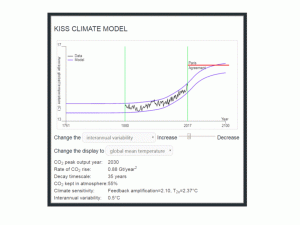
KISS (Keep It Simple, Stupid!) is advice often given in presentation-skills training. The KISS principle is, in my view, also a good idea when presenting information about Earth’s climate because keeping it simple is vital for transparency. I hope that anyone can understand what this model does and what its assumptions are.
KISS is set up to test two hypotheses:
1. Carbon dioxide is rising in the atmosphere because human activities are putting it there.
2. The global mean temperature is rising because carbon dioxide levels are rising.
KISS allows you to compare predictions, based on these assumptions, to what really happened. If the model and data match reasonably well, this is evidence in favour of the hypotheses. If they don’t match, the hypotheses are flawed. The idea is that you play with the model, get your head around its very simple assumptions, and then make your own mind up about whether the hypotheses are supported.
Once you’ve calibrated the model to test these hypotheses, you can then look at what the model predicts about the future. By what date does the model suggest we need to stop increasing our output of greenhouse gasses in order to hit the Paris-Agreement target of no more than a 2 Centigrade rise in temperatures?
You can run the KISS model by selecting Simulation from the KISS menu but it’s a good idea to first check out the Quick Start and Tutorial items from the same menu.
